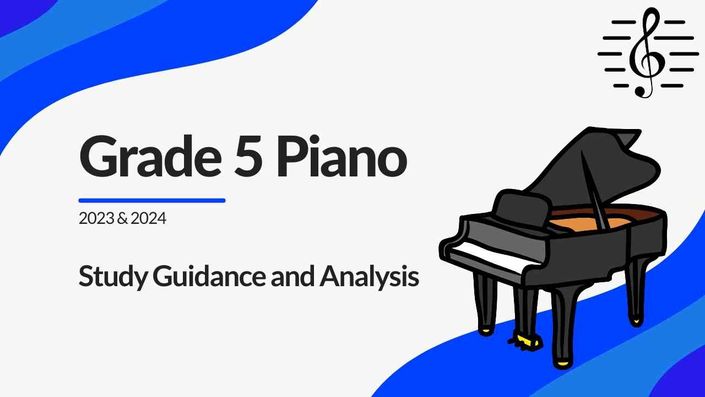
Grade 5 Piano Study Guidance and Analysis
Get to grips with the 2023 and 2024 ABRSM piano exam repertoire.
Enroll in Course
What You Will Learn
Invaluable guidance for teachers and students with the Grade 5 Piano Study Guidance and Analysis course.
Reach your potential with our thorough and comprehensive walk-through of each of the nine core pieces on the ABRSM 2023 & 2024 Grade 5 Piano Exam Pieces syllabus. This course explains the essential background to each piece, hints and tips for dealing with the technical and expressive demands, as well as giving the context of composer, style and mood. Each piece is analysed to give students and teachers a strong grasp of the melodic, rhythmic, harmonic, structural and texture issues in order to equip an authentic, imaginative, high level performance. The course is designed for students, for teachers, and for those preparing for the Teaching DipABRSM. During the Grade 5 Piano Study Guidance and Analysis course we'll cover...
- Technical Considerations - Which sections are the most technically demanding? How could you best practice this particular piece? What techniques does this piece employ?
- Implications of the Expressive Detail - How could you expressively paint your performance? What do the underlying elements of the composition suggest? What considerations chould you give to the style and period to produce a successful performance?
- Compositional Design - Do you understand phrasing, tempo, dynamics? How do you deal with pitch, rhythm and deal with pulse? What are the highlights within the piece?
- Historic Background - What is the essential background to the composer? How does the piece fit in with it's historical context? What can be said about the overall mood and style?
- Performance Approach - How should you approach playing this piece as a student? What approach should you take as a teacher? What technical exercises should you be practising?
I have been watching different videos but none of them were as good as yours. Thank you sooo much, it is great. I hope all those searching for piano lessons find these videos sooner rather than watching 100 of other videos.
- Fathima

Who Is This Course For?
Students, teachers, and for those preparing for the Teaching DipABRSM.
Thoroughly understanding a piece is key to achieving a high level of musicianship and top marks in an exam. The Grade 5 Piano Study Guidance and Analysis course is for students wanting to perform the graded pieces at a high level with confidence and understanding. It is also for teachers wanting to gain insight into how to teach these pieces to their students. Additionally, it is for those preparing for the Teaching DipABRSM who require an in-depth look at the music.
Do any of these sound familiar?
"I’m happy learning the pieces but would like to understand what the composer is doing..." "I am preparing for the DipABRSM Teaching Diploma and need to be able to explain what’s going on in these pieces..." "My students do alright in exams but I would like to know how I could get them to achieve higher marks in the pieces…" "I would like to discover how the design of melody, rhythm, chords, structure, organisation of the texture and other factors such as style and period might lead me to an effective interpretation of these pieces..." "As a teacher I would like to get a grip on the key things to look for in the pieces so I can work with my students effectively…"
↓
Your piano lessons are so good. I’ve started from scratch and I’ve already learnt a lot. Thank you so much!
- Rahma

By the end of the Grade 5 Piano Study Guidance and Analysis course you'll be able to…

Confidently learn and perform these pieces to a high standard

Expertly teach these pieces with a deep understanding of their inner workings

Brilliantly grasp the salient issues present in these pieces required for a teaching diploma

Interpret each piece in an inspirational way, absorbing the expressive detail and historical context

Easily analyse the key points relating to melody, rhythm, harmony, texture and structure for each piece

Approach each piece from a practical standpoint with helpful practice procedures to help overcome technical issues
Gareth is one of the best teachers in my entire life. Whether you want to learn Piano or want to learn to teach Piano, Music matters is the best place and Mr. Gareth Green is the best teacher for both. Thank you so much sir for all that you have been doing to me. God bless you forever.
- Ramesh

Course Information
What's Included with the Grade 5 Piano Study Guidance and Analysis Course?
Professional Teaching
You'll receive expert teaching, inherent in putting together a confident performance that will fulfil the requirements of the ABRSM criteria.
Practical Knowledge
Each video demonstrates the essentials required for learning in terms of notes, rhythms, fingering issues etc. before exploring the construction of each work.
Ask Questions
Below each video you are able to post comments and ask questions should you have any in regards to the course topics or any of the pieces covered.
Easy to Follow Structure
The course is divided into multiple stages, breaking down each part separately before putting it all together.
Complete at Your Own Pace
You can easily fit the course around your regular commitments, completing it at your own pace and in your own time.
Anywhere Access
Your course never expires. Learn when and where you choose! Computer or mobile. Just get comfortable and dive in!
↓
Your Instructor

Hi, I’m Gareth and I'm passionate about developing ‘the all round musician’.
Over 35 years of music examining with ABRSM, work with the BBC on Radio and TV, experience on the international concert platform, as a published composer and arranger, have brought rich resources to the 40 years of teaching in which I've engaged.
Scholarships at The Royal College of Music, Oxford University and St. Paul’s Cathedral gave me fantastic opportunities to learn from the best musicians, scholars and teachers. Working as Director of Music at Queen Elizabeth Grammar School then provided a wonderful opportunity to develop my teaching skills.
Teaching individuals and groups of all ages, and at all stages of development have refined a teaching approach that I hope is fun and engaging, and focused on explaining things clearly and logically. And that is what these courses are all about - understanding the basic principles with clarity, then going deeper, applying them to your musical life and liberating yourself as a musician.
It’s a rich and amazing journey, and I can’t wait for you to join me today!
Course Curriculum
-
StartIntroduction (39:56)
-
StartA1: Allegro - Domenico Cimarosa (39:27)
-
StartA2: Minuet and Trio - Joseph Haydn (40:54)
-
StartA3: Jester's Jig - Chee-Hwa Tan (31:52)
-
PreviewB1: Minnelied - Heinrich Hofmann (36:57)
-
StartB2: Wind in the Willows - Bernadette Marmion (40:08)
-
StartB3: Philomela - Dorothy Pilling (38:07)
-
StartC1: In the Groove - Mike Cornick (25:31)
-
StartC2: Scherzo - D. B. Kabalevsky (38:34)
-
StartC3: A Distant Star in the Stillness - David A. T. Önaç (33:39)
Frequently Asked Questions
A Letter from Gareth Green
MA (Oxon), MA (Leeds), FRCO(CHM), FLCM, ARCM
When it comes to exam pieces many students and teachers do a great job learning the notes and some take care to embrace the expressive detail provided by the composer or editor. What more is there to consider?
The ABRSM marking criteria provides a fabulous guide, not only for examiners but also for teachers and students. It’s well worth absorbing if you’re not familiar with it. Most people might expect to be assessed on the accuracy of notes, rhythmic flow, accurate coordination of the hands and other essentials but by digging deeper we can achieve a real connection with the music that is guaranteed to bring any performance to life. When it comes to the area of ‘Time’ on the criteria, for example, we need to be sure that the piece is being played at an appropriate tempo, that the rhythm is secure, that a strong sense of pulse is evident, and that rhythmic flexibility is applied where appropriate. When it comes to tone, does the performance demonstrate beautiful sound and is there variety of colour in the tone or is the sound rather monochrome, or over strident, or rather pale and apologetic? Is the texture well balanced, or does the accompaniment drown melodic lines? Is the dynamic range broad or rather restricted? Is the phrasing and articulation accurate and consistent, or is it absent, inconsistent, or only present in part, or over-stated or under-stated? Are the phrases presented with a sense of musical shape or is the playing rather directionless? Is the performance assured or rather lacking in confidence, or is it simply rather pedestrian and unimaginative? These are examples of what one should be considering in order to achieve a convincing performance that aligns with the stated criteria.
At the same time, it is important to stress that there is not an ‘ABRSM way’ to play the pieces. ABRSM goes to great lengths to reassure candidates and teachers that any convincing performance will be favourably assessed by examiners.
How do we ensure that we or our students give convincing performances?
In addition to the above, we need to have a good understanding of what is going on in each piece so we can highlight important points in melodic lines, in the rhythm, in the harmony, in the texture, and in the structure of the piece. We need to capture the musical character through the ways in which we approach rhythm, articulation, tempo, dynamics, balance between the hands, as well as through our understanding of the style and mood of the piece, of the composer, and of the historical context.
This course takes each of the pieces printed in the grade books and unpacks all of the above. Whether you are a student or exam candidate learning these pieces, or a teacher teaching these pieces, or a teacher preparing for the DipABRSM Teaching, this course will be invaluable to you. The content crystallises years of study and decades of teaching and examining experience, which it is my honour and pleasure to pass on to you.
I hope you enjoy the course and whether you are a student, a teacher, or someone preparing for DipABRSM, I wish you all the very best.
— Gareth Green, Music Matters




